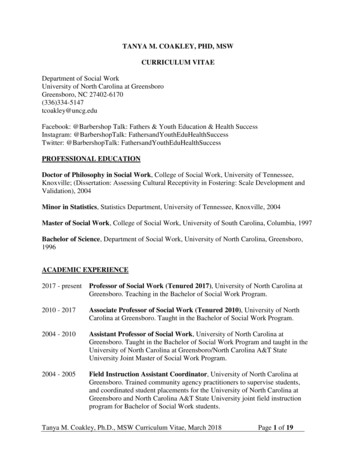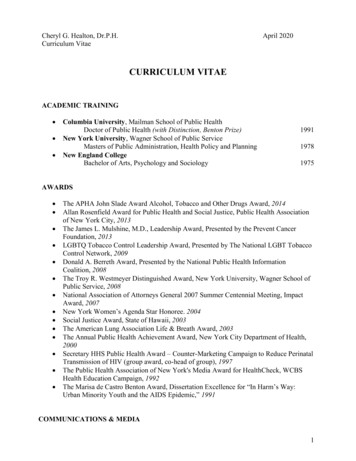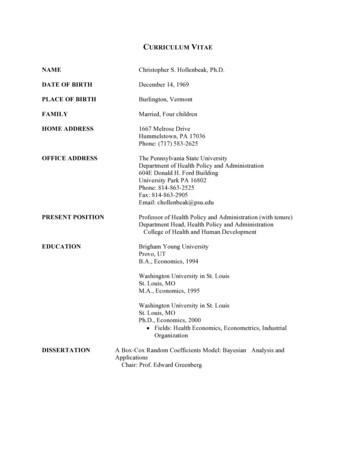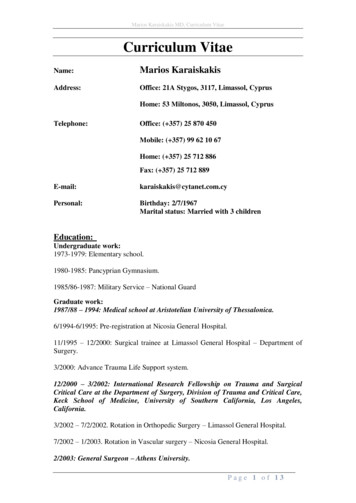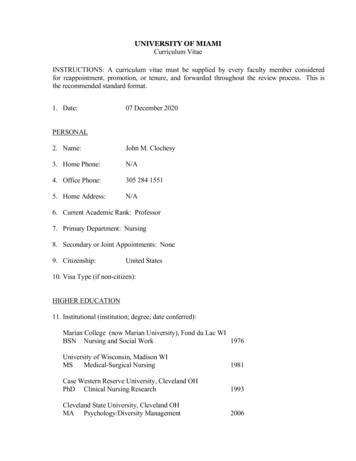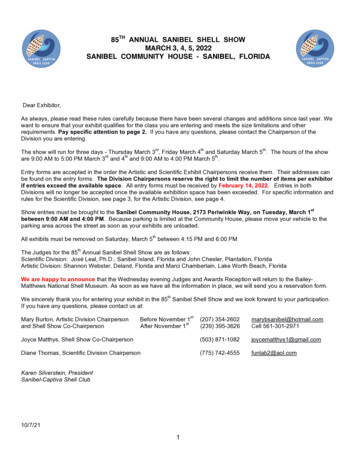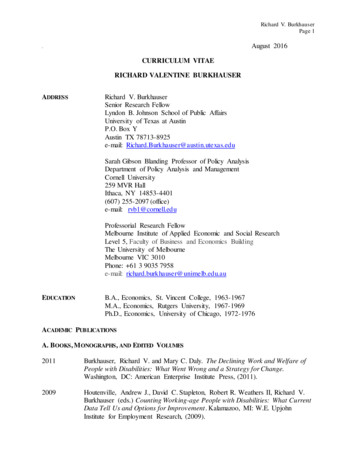
Transcription
Richard V. BurkhauserPage 1August 20162BCURRICULUM VITAERICHARD VALENTINE BURKHAUSERADDRESSRichard V. BurkhauserSenior Research FellowLyndon B. Johnson School of Public AffairsUniversity of Texas at AustinP.O. Box YAustin TX 78713-8925e-mail: Richard.Burkhauser@austin.utexas.eduSarah Gibson Blanding Professor of Policy AnalysisDepartment of Policy Analysis and ManagementCornell University259 MVR HallIthaca, NY 14853-4401(607) 255-2097 (office)e-mail: rvb1@cornell.eduProfessorial Research FellowMelbourne Institute of Applied Economic and Social ResearchLevel 5, Faculty of Business and Economics BuildingThe University of MelbourneMelbourne VIC 3010Phone: 61 3 9035 7958e-mail: richard.burkhauser@unimelb.edu.auEDUCATIONB.A., Economics, St. Vincent College, 1963-1967M.A., Economics, Rutgers University, 1967-1969Ph.D., Economics, University of Chicago, 1972-1976ACADEMIC PUBLICATIONSA. BOOKS , M ONOGRAPHS , AND EDITED VOLUMES2011Burkhauser, Richard V. and Mary C. Daly. The Declining Work and Welfare ofPeople with Disabilities: What Went Wrong and a Strategy for Change.Washington, DC: American Enterprise Institute Press, (2011).2009Houtenville, Andrew J., David C. Stapleton, Robert R. Weathers II, Richard V.Burkhauser (eds.) Counting Working-age People with Disabilities: What CurrentData Tell Us and Options for Improvement. Kalamazoo, MI: W.E. UpjohnInstitute for Employment Research, (2009).
Richard V. BurkhauserPage 22004Clark, Robert, Richard V. Burkhauser, Marilyn Moon, Joseph F. Quinn, andTimothy M. Smeeding. The Economics of an Aging Society. Malden, MA:Blackwell Publishing Company, (2004).2003Stapleton, David C. and Richard V. Burkhauser (eds.) The Decline in Employmentof People with Disabilities: A Policy Puzzle. Kalamazoo, MI: W.E. UpjohnInstitute for Employment Research, (2003).2001Budetti, Peter P., Richard V. Burkhauser, Janice M. Gregory, and H. Allan Hunt(eds.) Ensuring Health and Income Security for an Aging Workforce. Kalamazoo,MI: W.E. Upjohn Institute for Employment Research, (2001).1999Burkhauser, Richard V., F. Thomas Juster, and Jules J.M. Theeuwes (eds.) TheHealth, Wealth and Work of Older People, Special Issue, Labour Economics,Vol. 6 (2), (June 1999).1996Burkhauser, Richard V., Amy D. Crews, Mary C. Daly, and Stephen P. Jenkins.Income Mobility and the Middle Class, AEI Studies on Understanding EconomicInequality. Washington, DC: The AEI Press, (1996).Mashaw, Jerry, Virginia Reno, Monroe Berkowitz, and Richard V. Burkhauser(eds.) Disability, Work, and Cash Benefits. Kalamazoo, MI: W.E. UpjohnInstitute for Employment Research, (1996).Aarts, Leo J.M., Richard V. Burkhauser, and Philip R. de Jong (eds.) Curing theDutch Disease: An International Perspective on Disability Policy Reform.Aldershot, Great Britain: Avebury, Ashgate Publishing Ltd., (1996).1995Burkhauser, Richard V. and Paul J. Gertler (eds.) The Health and RetirementSurvey: Data Quality and Early Results, Journal of Human Resources, 30(Supplement), (December 1995).1994Burkhauser, Richard V. and Gert G. Wagner (eds.) Special Issue,Vierteljahrshefte Zur Wirtschaftsforschung, No. 2, (1994).1993Burkhauser, Richard V. and Dallas L. Salisbury (eds.) Pensions in a ChangingEconomy. Washington, DC: Employee Benefit Research Institute, (1993).1990Quinn, Joseph F., Richard V. Burkhauser, and Daniel A. Myers. Passing theTorch: The Influence of Economic Incentives on Work and Retirement.Kalamazoo, MI: W.E. Upjohn Institute for Employment Research, (1990).1984Haveman, Robert H., Victor Halberstadt, and Richard V. Burkhauser. PublicPolicy Toward Disabled Workers: A Cross-National Analysis of EconomicImpacts. Ithaca, New York: Cornell University Press, (1984).
Richard V. BurkhauserPage 31982Burkhauser, Richard V. and Karen C. Holden (eds.) A Challenge to SocialSecurity: The Changing Roles of Women and Men in American Society. NewYork: Academic Press, (1982).Burkhauser, Richard V. and Robert H. Haveman. Disability and Work: TheEconomics of American Policy. Baltimore: Johns Hopkins University Press,(1982).1977Tolley, George S. and Richard V. Burkhauser (eds.) Income Support Policies forthe Aged. Boston, MA: Ballinger, (1977).B. ARTICLESForthcomingBurkhauser, Richard V., Mary C. Daly, and Nicolas Ziebarth. “ProtectingWorking-Age People with Disabilities: Experiences of Four IndustrializedNations.” Journal for Labour Market Research.Burkhauser, Richard V. and Mary C. Daly. “Making Work a Priority forWorking-Age People with Disabilities” in Michael Strain (ed.) The US LaborMarket: Questions and Challenges for Public Policy. American EnterpriseInstitute.2016Armour, Philip, Richard V. Burkhauser, and Jeff Larrimore. 2016. “Using thePareto Distribution to Improve Estimates of Topcoded Earnings.” EconomicInquiry, 54(2) (April): 1263-1273.Sabia, Joseph J., Richard V. Burkhauser, and Benjamin Hansen. 2016. “WhenGood Measurement Goes Wrong: New Evidence that New York State’sMinimum Wage Reduced Employment.” Industrial and Labor Relations Review,69(2) (March): 312-319.Burkhauser, Richard V., Matt Hall, Markus Hahn, and Nicole Watson. 2016.“Australia Farewell: Predictors of Emigration in the 2000s.” Population Researchand Policy Review. 35(2), 197-215. DOI: 10.1007/s11113-016-9383-3.Burkhauser, Richard V., Markus H. Hahn, Dean R. Lillard, and Roger Wilkins.2016. “Does Income Inequality in Early Childhood Predict Self-Reported Healthin Adulthood? A Cross-National Comparison of the United States and GreatBritain” in Lorenzo Cappellari, Solomon W. Polachek, and KonstantinosTatsiramos (eds.) Inequality: Causes and Consequences (Research in LaborEconomics, Vol. 43) Emerald Group Publishing Limited: 407-476.2015Larrimore, Jeff, Richard V. Burkhauser, and Philip Armour. 2015. “Accountingfor Income Changes over the Great Recession: The Importance of Taxes andTransfers.” National Tax Journal, 68(2): 281-318.
Richard V. BurkhauserPage 4Lillard, Dean R., Richard V. Burkhauser, Markus H. Hahn, and Roger Wilkins.2015. “Does Early-Life Income Inequality Predict Self-Reported Health In LaterLife? Evidence from the United States.” Social Science and Medicine, 128(March): 347-355.Burkhauser, Richard V., Markus Hahn, and Roger Wilkins. 2015. “MeasuringTop Incomes Using Tax Records Data: A Cautionary Tale from Australia.”Journal of Economic Inequality, 13 (2): 181-205.Burkhauser, Richard V., T. Lynn Fisher, Andrew J. Houtenville, and JenniferTennant. 2015. “Is the 2010 Affordable Care Act Minimum Standard to IdentifyDisability in All National Datasets Good Enough for Policy Purposes?” Journalof Economic and Social Measurement. 39 (2): 217-245.Burkhauser, Richard V. 2015. “The Minimum Wage versus the Earned IncomeTax Credit for Reducing Poverty.” IZA World of Labor: Evidence-based PolicyMaking: 153. doi: 10.15185/izaw ol.1532014Armour, Philip, Richard V. Burkhauser, and Jeff Larrimore. 2014. “Levels andTrends in United States Income and Its Distribution: A Crosswalk from MarketIncome towards a Comprehensive Haig-Simons Income Measure.” SouthernEconomic Journal, 81 (2): 271-293.Burkhauser, Richard V. and Jeff Larrimore. 2014. “The Top One Percent.”Journal of Economic Perspectives, 28 (1): 245-247.Bayaz-Ozturk, Gulgun, Richard V. Burkhauser, and Kenneth A. Couch. 2014.“Consolidating the Evidence on Income Mobility in the Western States ofGermany and the United States from 1984 to 2006.” Economic Inquiry, 52 (1):431-443.Burkhauser, Richard V. 2014. “Another Look at the Economics of MinimumWage Legislation.” Australian Economic Review, 47 (3): 409-415Burkhauser, Richard V., Mary C. Daly, Duncan McVicar and Roger Wilkins.2014. “Disability Benefit Growth and Disability Reform in the United States:Lessons from Other OECD Nations.” IZA Journal of Labor Policy, 3:4: 1-30.Burkhauser, Richard V., Andrew J. Houtenville, and Jennifer Tennant. 2014.“Capturing the Elusive Working-Age Population with Disabilities: ReconcilingConflicting Social Success Estimates from the Current Population Survey andAmerican Community Survey.” Journal of Disability Policy Studies, 24 (4): 195205. (first published online June 5, 2012).Burkhauser, Richard V., and Jeff Larrimore. 2014. “Median Income and IncomeInequality: From 2000 and Beyond.” John Logan (ed.), Diversity and Disparities:America Enters a New Century, Russell Sage Foundation, pp. 105-138.
Richard V. BurkhauserPage 52013Armour, Philip, Richard V. Burkhauser, and Jeff Larrimore. “DeconstructingIncome and Income Inequality Measures: A Cross-Walk from Market Income toComprehensive Income.” American Economic Review, 103, (3) (May): 173-177.Burkhauser, Richard V., Jeff Larrimore, and Kosali Simon. “Measuring theImpact of Valuing Health Insurance on Levels and Trends in Inequality and Howthe Affordable Care Act of 2010 Could Affect Them.” Contemporary EconomicPolicy, 31, (4): 779-794.Burkhauser, Richard V., Mary C. Daly, and Brian T. Lucking. “Is Australia OneRecession Away from a Disability Blowout? Lessons from Other Organisationsfor Economic Co-operation and Development Countries.” Australian EconomicReview, 46 (3): 357-368.Burkhauser, Richard V. “Comments on Nudged, Pushed or Mugged: Policies toEncourage Older Workers to Retire Later.” Gary Burtless and Henry J. Aaron(eds.), Closing the Deficit: How Much Can Later Retirement Help? Washington,DC: Brookings Institute Press: 93-99.Burkhauser, Richard V., Andrew J. Houtenville, and Jennifer Tennant.“Measuring the Population with Disabilities for Policy Analysis.” Kenneth A.Couch, Mary C. Daly and Julie Zissimopoulos (eds.), Lifecycle Events andEconomic Security: The Roles of Job Loss, Disability and Changing FamilyStructure. Stanford University Press: 215-239.2012Burkhauser, Richard V., Shuaizhang Feng, Stephen Jenkins and Jeff Larrimore.“Recent Trends in Top Income Shares in the USA: Reconciling Estimates fromMarch CPS and IRS Tax Return Data.” Review of Economics and Statistics, 94(2) (May): 371-388.Sabia, Joseph J., Richard V. Burkhauser, and Benjamin Hansen. “Are the Effectsof Minimum Wage Increases Always Small? New Evidence from a Case Study ofNew York State.” Industrial and Labor Relations Review, 65 (2) (April): 350-376.Burkhauser, Richard V., Maximilian Schmeiser, and Robert Weathers II. “TheImportance of Anti-Discrimination and Workers’ Compensation Laws on theProvision of Workplace Accommodations Following the Onset of a Disability.”Industrial and Labor Relations Review, 65 (1) (January): 161-180.Burkhauser, Richard V. and Mary C. Daly. “Social Security Disability Insurance:Time for Fundamental Change.” Journal of Policy Analysis and Management, 31(2): 454-461.Burkhauser, Richard V., Jeff Larrimore and Kosali Simon. “A Second Opinion onthe Economic Health of the American Middle Class and Why it Matters inGauging the Impact of Government Policy.” National Tax Journal, 65 (March):7-32. Winner of the 2012 Richard Musgrave Prize for best paper published in the
Richard V. BurkhauserPage 6National Tax Journal. Winner of the 2013 Addington Prize in Measurementpresented by the Fraser Institute.Burkhauser, Richard V. “Deconstructing European Poverty Measures,” DouglasBesharov and Kenneth Couch (eds.), Counting the Poor: New Thinking AboutEuropean Poverty Measures and Lessons for the U.S., Oxford University Press.(2012), pp. 79-94.2011Jenkins, Stephen P., Richard V. Burkhauser, Shuaizhang Feng, and Jeff Larrimore“Measuring Inequality Using Censored Data: A Multiple Imputation Approach.”Journal of the Royal Statistical Society (A), 174, Part 1 (2011), 63-81.Burkhauser, Richard V., Shuaizhang Feng, Stephen Jenkins, and Jeff Larrimore.“Trends in United States Income Inequality Using the Internal March CurrentPopulation Survey: The Importance of Controlling for Censoring.” Journal ofEconomic Inequality. 9 (3) (2011): 393-415.Burkhauser, Richard V. “Evaluating the Questions that Alternative Policy SuccessMeasures Answer.” Journal of Policy Analysis and Management, 30 (2) (2011):205-215.Bayaz, Gulgun, Richard V. Burkhauser, and Kenneth A. Couch. “Trends inIntragenerational Income Mobility in the Western States of Germany and theUnited States (1984-2006).” Schmollers Jahrbuch: Journal of Applied SocialScience Studies, 131 (2) (2011): 359-368.2010Sabia, Joseph J. and Richard V. Burkhauser. “Minimum Wages and Poverty:Will a 9.50 Federal Minimum Wage Really Help the Working Poor?” SouthernEconomic Journal, 76 (3) (January 2010): 592-623. Winner of the 2010Georgescu-Roegen Prize for the best academic article published in the SouthernEconomic Journal.Burkhauser, Richard V., Shuaizhang Feng, and Jeff Larrimore. “ImprovingImputations of Top Incomes in the Public-Use Current Population Survey byUsing Both Cell-Means and Variances.” Economic Letters, 108 (2010) 69-72.Burkhauser, Richard V. “An American Perspective on the 2010 Increase in theAustralian Minimum Wage.” Australian Bulletin of Labour, 36 (3) (September2010): 335-340.Burkhauser, Richard V. and Kenneth A. Couch. “Are the Inequality and MobilityTrends of the United States in the European Union’s Future?” Jens Alber and NeilGilbert (eds.), United in Diversity, Oxford University Press. (2010), pp. 280-307.Burkhauser, Richard V. and Andrew J. Houtenville, “Employment AmongWorking-Age People with Disabilities: What Current Data Can Tell Us.” EdnaMora Szymanski and Randall M. Parker (eds.), Work and Disability: Issues and
Richard V. BurkhauserPage 7Strategies for Career Development and Job Placement (3rd ed.) Austin, TX: ProEd, Inc. (2010), pp. 49-86.2009Burkhauser, Richard V. “Deconstructing European Poverty Measures: WhatRelative and Absolute Scales Measure.” Journal of Policy Analysis andManagement, 28 (4) (Fall 2009): 715-724.Burkhauser, Richard V., Shuaizhang Feng, and Stephen Jenkins. “Using aP90/P10 Ratio to Measure Inequality Trends with the Public Use CurrentPopulation Survey: A View from Inside the Census Bureau Vaults.” The Reviewof Income and Wealth, 55 (1) (March 2009): 166-185.Burkhauser, Richard V., John Cawley, and Maximilian D. Schmeiser. "TheTiming of the Rise in U.S. Obesity Varies With Measure of Fatness." Economicsand Human Biology, 7 (2009): 307-318.Burkhauser, Richard V. and John Cawley. “Adding Biomeasures Relating toFatness and Obesity to the Panel Study of Income Dynamics.” Biodemographyand Social Biology, 55 (2) (2009): 118-139.Burkhauser, Richard V. and Jeff Larrimore. “Using Internal CPS Data toReevaluate Trends in Labor-Earnings Gaps.” Monthly Labor Review, (August2009): 3-18.Burkhauser, Richard V., Alan Gustman, John Laitner, Olivia Mitchell, andAmanda Sonnega, “Social Security Research at the Michigan RetirementResearch Center.” Social Security Bulletin, 69 (4) (2009): 51-64.Burkhauser, Richard V. and Jeff Larrimore. “Trends in the Relative HouseholdIncome of Working-Age Men With Work Limitations: Correcting the RecordUsing Internal Current Population Survey Data.” Journal of Disability PolicyStudies, 20 (3) (December 2009): 162-169.Stapleton, David C., Richard V. Burkhauser, Peiyun She, Robert R. Weathers II,and Gina A. Livermore. “Income Security for Workers: A Stressed SupportSystem in Need of Innovation.” Journal of Disability Policy Studies, 19 (4)(Spring 2009): 204-220.Burkhauser, Richard V. and Kenneth A. Couch. “Intragenerational Inequality andIntertemporal Mobility.” Wiemer Salverda, Brian Nolan, and Timothy Smeeding(eds.), The Oxford Handbook of Income Inequality, Oxford University Press,(2009), pp. 522-548.Burkhauser, Richard V. and Ludmila Rovba. “Institutional Responses toStructural Lag: The Changing Patterns of Work at Older Ages.” Sara J. Czaja andJoseph Sharit (eds.), Aging and Work. John Hopkins University Press: Baltimore,MD. (2009), pp. 9-34.
Richard V. BurkhauserPage 8Burkhauser, Richard V., Ludmila Rovba, and Robert Weathers II. “HouseholdIncome.” Andrew J. Houtenville, David C. Stapleton, Robert R. Weathers II, andRichard V. Burkhauser (eds.), Counting Working-age People with Disabilities:What Current Data Tell Us and Options for Improvement. Kalamazoo, MI: W.E.Upjohn Institute for Employment Research, (2009), pp. 143-190.Burkhauser, Richard V., Ludmila Rovba, and Andrew J. Houtenville. “Poverty.”Andrew J. Houtenville, David C. Stapleton, Robert R. Weathers II, and RichardV. Burkhauser (eds.), Counting Working-age People with Disabilities: WhatCurrent Data Tell Us and Options for Improvement. Kalamazoo, MI: W.E.Upjohn Institute for Employment Research, (2009), pp. 191-224.2008Burkhauser, Richard V. and John Cawley. “Beyond BMI: The Value of MoreAccurate Measures of Fatness and Obesity in Social Science Research.” Journalof Health Economics, 27 (2) (March 2008): 519-529.Larrimore, Jeff, Richard V. Burkhauser, Shuaizhang Feng and Laura Zayatz.“Consistent Cell Means for Topcoded Incomes in the Public Use March CPS(1976-2007).” Journal of Economic and Social Measurement, 33 (2-3) (2008):89-128.Burkhauser, Richard V. and Kosali I. Simon. “Who Gets What from EmployerPay or Play Mandates?” Risk Management and Insurance Review, 11 (1) (2008):75-102.Burkhauser, Richard V., Takashi Oshio, and Ludmila Rovba. “How theDistribution of After-Tax Income Changed Over the 1990s Business Cycle: AComparison of the United States, Great Britain, Germany, and Japan.” Journal ofIncome Distribution, 17 (1) (March, 2008): 87-109.Feng, Shuaizhang and Richard V. Burkhauser. “Generalized Percentile Ratios asRobust Measures of Labor Earnings Inequality.” International Journal of DataAnalysis Techniques and Strategies, 1 (2) (2008): 117-125.Burkhauser, Richard V. “Creating an EU Flexicurity System: An AmericanPerspective.” CESifo Dice Report, Journal of Institutional Comparisons, 6 (4)(2008): 36-40.2007Burkhauser, Richard V. and Joseph J. Sabia. “The Effectiveness of MinimumWage Increases in Reducing Poverty: Past, Present and Future.” ContemporaryEconomic Policy, 25 (2) (April 2007): 262-281.Weathers, Robert R., Gerard Walter, Sara Schley, John Hennessey, JeffreyHemmeter and Richard V. Burkhauser. “How Postsecondary Education ImprovesAdult Outcomes for Supplemental Security Income Children with Severe HearingImpairments.” Social Security Bulletin. 67 (2) (2007): 67n2p101.pdfHUU
Richard V. BurkhauserPage 9Burkhauser, Richard V. and Mathis Schroeder. “A Method for Comparing theEconomic Outcomes of the Working-Age Population with Disabilities inGermany and the United States.” Schmollers Jahrbuch: Journal of Applied SocialScience Studies, 127 (2) (2007): 227-258.Burkhauser, Richard V., Takashi Oshio, and Ludmila Rovba. “Winners andLosers over the 1990s Business Cycles in Germany, Great Britain, Japan, and theUnited States.” Schmollers Jahrbuch: Journal of Applied Social Science Studies,127 (1) (2007): 75-84.Burkhauser, Richard V. and Dean Lillard. “The Expanded Cross-NationalEquivalent File: HILDA Joins its International Peers.” Australian EconomicReview, 40 (2) (April 2007): 208-215.2006Feng, Shuaizhang, Richard V. Burkhauser and J.S. Butler. “Levels and LongTerm Trends in Earnings Inequality: Overcoming Current Population SurveyCensoring Problems Using the GB2 Distribution,” Journal of Business andEconomic Statistics, 24 (1) (January 2006): 57-62.Burkhauser, Richard V. and David C. Stapleton. “Disability.” Jeffrey H.Greenhaus and Gerard A. Callahan (eds.), Encyclopedia of Career Development.Thousand Oaks, CA: Sage Publication Co. Vol. 1 (May 2006), pp. 233-236.2005Burkhauser, Richard V. and Dean R. Lillard. “The Contribution and Potential ofData Harmonization for Cross-National Comparative Research,” Journal ofComparative Policy Analysis, 7 (4) (December 2005): 313-330.Burkhauser, Richard V., Philip Giles, Dean R. Lillard, and Johannes Schwarze.“Until Death Do us Part: An Analysis of the Economic Well-Being of Widows inFour Countries,” Journal of Gerontology, 60B (5) (September, 2005): S238-S246.Lillard, Dean R. and Richard V. Burkhauser. “Income Inequality and Health: ACross-Country Analysis” Schmollers Jahrbuch: Journal of Applied SocialScience Studies, 125 (1) (2005): 109-118.Burkhauser, Richard V. and Ludmila Rovba. “Income Inequality in the 1990s:Comparing the United States, Great Britain, and Germany.” The JapaneseJournal of Social Security Policy, 4 (1) (June 2005): 1-16.Burkhauser, Richard V. “Job Retention.” Gary L. Albrecht (ed.), Encyclopedia ofDisability. Thousand Oaks, CA: Sage Publishing Co. Vol. 3 (November 2005):987-989.2004Burkhauser, Richard V., J.S. Butler, and Gulcin Gumus. “A DynamicProgramming Model of Social Security Disability Insurance Application,”Journal of Applied Econometrics, 19 (6) (2004): 671-685.
Richard V. BurkhauserPage 10Burkhauser, Richard V., Kenneth A. Couch, Andrew J. Houtenville, and LudmilaRovba. “Income Inequality in the 1990s: Re-Forging a Lost Relationship?”Journal of Income Distribution, 12 (3-4) (2003-2004): 8-35.Burkhauser, Richard V., J.S. Butler, Shuaizhang Feng, Andrew J. Houtenville.“Long Term Trends in Earnings Inequality: What the CPS Can Tell Us,”Economic Letters, 82 (2) (February 2004): 295-299.Burkhauser, Richard V. and David C. Stapleton. “The Decline in theEmployment Rate for People with Disabilities: Bad Data, Bad Health, or BadPolicy?” Journal of Vocational Rehabilitation, 20 (3) (September 2004):185-201.Burkhauser, Richard V. and David C. Stapleton. “Employing Those NotExpected to Work: The Stunning Changes in the Employment of Single Mothersand People with Disabilities in the United States in the 1990s.” Bernd Marin,Christopher Prinz and Monika Queisser (eds.), Transforming Disability WelfarePolicies: Toward Work and Equal Opportunity. Burlington, VT: AshgatePublishing Co. (2004), pp. 321-332.2003Bound, John, Richard V. Burkhauser, and Austin Nichols. “Tracking theHousehold Income of SSDI and SSI Applicants.” Sol W. Polachek (ed.),Research in Labor Economics, 22 (2003), pp. 113-159.Daly, Mary C. and Richard V. Burkhauser. “The Supplemental Security IncomeProgram.” Robert Moffitt (ed.), Means Tested Transfer Programs in the UnitedStates. Chicago, IL: University of Chicago Press for the NBER, (2003), pp. 79140.Burkhauser, Richard V., Philip Giles, Dean R. Lillard and Johannes Schwarze.“Changes in the Economic Well-Being of Widows Following the Death of TheirHusband: A Four Country Comparison,” Schmollers Jahrbuch: Journal ofApplied Social Studies, 123 (1) (2003): 151-162. Reprinted in German in MartinHeidenreich, Hans-W. Micklitz, Andreas Oehler, Hans Rattinger and JohannesSchwarze (eds.), Europa nach der Osterweiterung: Europaforschung an derUniversität Bamberg, Kulturverlag Kadmos: Berlin (2005), 142-153.Burkhauser, Richard V. and David C. Stapleton. “Introduction.” David C.Stapleton and Richard V. Burkhauser (eds.), The Decline in Employment ofPeople with Disabilities: A Policy Puzzle. Kalamazoo, MI: W.E. UpjohnInstitute for Employment Research, (2003), pp.1-22.Burkhauser, Richard V., Andrew J. Houtenville, and David C. Wittenburg, “AUser’s Guide to Current Statistics on the Employment of People withDisabilities.” David C. Stapleton and Richard V. Burkhauser (eds.), The Declinein Employment of People with Disabilities: A Policy Puzzle. Kalamazoo, MI:W.E. Upjohn Institute for Employment Research, (2003), pp. 23-86.
Richard V. BurkhauserPage 11Burkhauser, Richard V., and David C. Stapleton, “A Review of the Evidence andits Implications for Policy Change.” David Stapleton and Richard V. Burkhauser(eds.), The Decline in Employment of People with Disabilities: A Policy Puzzle.Kalamazoo, MI: W.E. Upjohn Institute for Employment Research, (2003), pp.369-406.Burkhauser, Richard V. and Andrew J. Houtenville, “Employment AmongWorking-Age People with Disabilities: What Current Data Can Tell Us.” EdnaMora Szymanski and Randall M. Parker (eds.), Work and Disability: Issues andStrategies for Career Development and Job Placement (2nd ed.). Austin, TX:Pro-Ed, Inc., (2003), pp. 53-90.Daly, Mary C. and Richard V. Burkhauser. “Left Behind: SSI in the Era ofWelfare Reform,” Focus, 22 (3) (2003): 35-43.Stapleton, David C. and Richard V. Burkhauser. “Contrasting the Employment ofSingle Mothers and People with Disabilities,” Employment Research, 10 (3) (July2003): 3-6.2002Burkhauser, Richard V., Mary C. Daly, Andrew J. Houtenville, and Nigar Nargis.“Self-Reported Work Limitation Data: What They Can and Cannot Tell Us,”Demography, 39 (3) (August 2002): 541-555.Burkhauser, Richard V. and Mary C. Daly. “U.S. Disability Policy in a ChangingEnvironment,” Journal of Economic Perspectives, 16 (1) (Winter 2002): 213-224.Burkhauser, Richard V., J.S. Butler, and Robert R. Weathers II. “How PolicyVariables Influence the Timing of Social Security Disability InsuranceApplications,” Social Security Bulletin, 64 (1) (2002): 52-83.2001Burkhauser, Richard V., “What Policymakers Need to Know about PovertyDynamics,” Journal of Policy Analysis and Management, 20 (4) (Fall 2001):757-759.Burkhauser, Richard V. and Timothy M. Smeeding, “The Role of Micro-LevelPanel Data in Policy Research,” Schmollers Jahrbuch: Journal of Applied SocialScience Studies, 121 (4) (2001): 469-500.Burkhauser, Richard V. and Robert R. Weathers II. “Access to Wealth AmongOlder Workers and How it is Distributed: Data From the Health and RetirementStudy.” Thomas M. Shapiro and Edward N. Wolff (eds.), Assets for the Poor:The Benefits of Spreading Asset Ownership. New York: Russell Sage Press,(2001), pp. 74-131.
Richard V. BurkhauserPage 12Burkhauser, Richard V., Mary C. Daly and Andrew J. Houtenville. “HowWorking Age People with Disabilities Fared Over the 1990s Business Cycle.”Peter Budetti, Richard V. Burkhauser, Janice Gregory and Allan Hunt (eds.),Ensuring Health and Income Security for an Aging Workforce. Kalamazoo, MI:W.E. Upjohn Institute for Employment Research, (2001), pp. 291-346.Burkhauser, Richard V., Barbara A. Butrica, Mary C. Daly, and Dean R. Lillard.“The Cross-National Equivalent File: A Product of Cross-National Research.”Irene Becker, Notburga Ott, and Gabriele Rolf (eds.) Soziale Sicherung In EinerDynamischen Gesellschaft. Frankfurt, Germany: Campus Verlagi, (2001),pp. 354-376.Burkhauser, Richard V., Dean R. Lillard and Paola M. Valenti. “Long-TermLabor Force Exit and Economic Well-Being: A Cross-National Comparison ofPublic Income Support,” Vierteljahrsheft Zur Wirtschaftsforschung, No. 1 (2001),pp. 146-152.2000Burkhauser, Richard V., Kenneth A. Couch and David C. Wittenburg. “AReassessment of the New Economics of the Minimum Wage Literature UsingMonthly Data from the CPS,” Journal of Labor Economics, 18 (4) (October2000): 653-680.Burkhauser, Richard V., Kenneth A. Couch and David C. Wittenburg. “WhoMinimum Wage Increases Bite: An Analysis Using Monthly Data from the SIPPand CPS,” Southern Economic Journal, 67 (1) (July 2000): 16-40.Burkhauser, Richard V. “An Economic Prospective on ADA Backlash:Comments from the Symposium on the Americans with Disabilities Act,”Berkeley Journal of Employment and Labor Law, 21 (1) (2000): 367-376.1999Bound, John and Richard V. Burkhauser. “Economic Analysis of TransferPrograms Targeted on People with Disabilities.” Orley C. Ashenfelter and DavidCard (eds.), Handbook of Labor Economics. Volume 3C. Amsterdam: ElsevierScience, (1999), pp. 3417-3528.Burkhauser, Richard V., J.S. Butler, Yang-Woo Kim, and Robert Weathers. “TheImportance of Accommodation on the Timing of Male Disability InsuranceApplication: Results from the Survey of Disability and Work and the Health andRetirement Study,” Journal of Human Resources, 34 (3) (Summer 1999): 589611.Burkhauser, Richard V., Amy D. Crews, Mary C. Daly, and Stephen P. Jenkins.“Testing the Significance of Income Distribution Changes Over the 1980sBusiness Cycle: A Cross-National Comparison,” Journal of AppliedEconometrics, 14 (3) (May – June 1999): 253-272.
Richard V. BurkhauserPage 13Burkhauser, Richard V., F. Thomas Juster, and Jules J.M. Theeuwes.“Introduction,” The Health, Wealth, and Work of Older People, Special IssueLabour Economics, Vol. 6. No. 2, (June 1999): vii - ix.Burkhauser, Richard V., Amy Crews-Cutts, and Dean R. Lillard. “How OlderPeople in the United States and Germany Fared in the Growth Years of the 1980s:A Cross-Sectional versus a Longitudinal View,” Journal of Gerontology: SocialScience, 54B, (5) (September 1999): S279-S290.Burkhauser, Richard V., Debra Dwyer, Maarten Lindeboom, Jules Theeuwes, andIsolde Woittiez. “Health, Work, and Economic Well-Being of Older Workers,Aged 51 to 61: A Cross-National Comparison Using the United States HRS andThe Netherlands CERRA Data Sets.” James Smith and Robert Willis (eds.),Wealth, Work, and Health: Innovations in Measurement in the Social Sciences.Ann Arbor, MI: University of Michigan Press, (1999), pp. 233-265.Burkhauser, Richard V. “The Use of Functional Capacity Measures in Public andPrivate Programs in the United States and in Other Countries.” Gooloo S.Wunderlich (ed.), Measuring Functional Capacity and Work Requirements.Washington, DC: National Academy Press, (1999), pp. 63-68.Burkhauser, Richard V. “Touching the Third Rail: Alternative Solutions forBringing the Social Security Retirement System into Long Term Balance.” JamesC. Hickman (ed.), The 1996 Bowles Symposium, Society of Actuaries MonographM-RS99-1, (1999), pp. 23-29.Burkhauser, Richard V., J.S. Butler, and Andrew J. Houtenville. “Changes inPermanent Income Inequality in the United States and Germany in the 1990s,”Vierteljahrsheft Zur Wirtschaftsforschung, No. 2 (1999): 284-289.1998Burkhauser, Richard V. and Mary C. Daly. “Disability and Work: TheExperiences of American and German Men,” Federal Reserve Bank of SanFrancisco Economic Review, 2 (1998): 17-29.Burkhauser, Richard V. “Policies to Make Work Pay for People withDisabilities.” Kalman Rupp and David Stapleton (eds.), Growth in DisabilityBenefits. Kalamazoo, MI: W.E. Upjohn Institute for Employment Research(1998), pp. 365-372.Burkhauser, Richard V. “Summing Up: Reflections on the Past and Future ofDisability Policy.” Kalman Rupp and David Stapleton (eds.), Growth inDisability Benefits. Kala
Lyndon B. Johnson School of Public Affairs University of Texas at Austin P.O. Box Y Austin TX 78713-8925 e-mail: Richard.Burkhauser@austin.utexas.edu Sarah Gibson Blanding Professor of Policy Analysis Department of Policy Analysis and Management Cornell University 259 MVR Hall Ithaca, NY 14853-4401 (607) 255-2097 (office)


